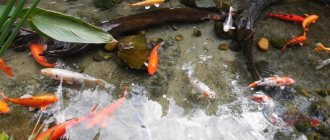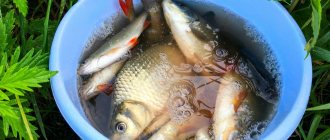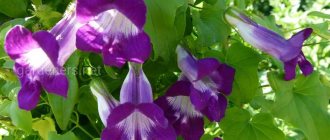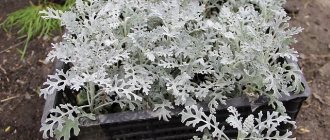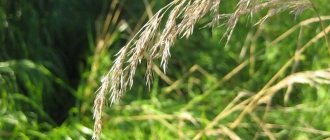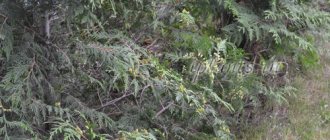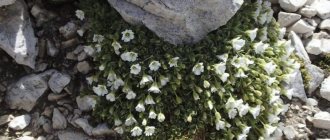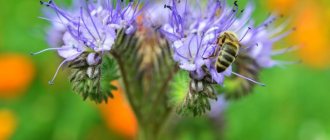If you don’t have a pond at your summer cottage, now is the time to correct this mistake. Autumn is the best time to create a pond in your country house. There is less housework, the site is almost empty, and the groundwater level is low. Get to work!
You can't live without a lake for weeks because you're a passionate fisherman? Or are you one of those people who can spend hours contemplating the life of the silent inhabitants of bodies of water? No matter who you are, you simply need a fish pond at your dacha. It doesn't matter what size your plot is. Both on an area of 6 acres and on an area of 0.5 hectares, if desired, you can place a pond with living inhabitants. The main thing is to approach the matter wisely.
Selecting a location
When creating a fish pond, its correct location is important. The lowest, sunny place on your site is well suited for this purpose.
There should be no trees or shrubs nearby - their roots can damage the bowl of the reservoir. It is also recommended to locate the pond away from buildings to prevent their shrinkage.
Dimensions
The optimal size of a reservoir for fish farming is 15-50 sq.m, the depth should be at least 1 meter and no more than 3, and it is preferable that the bottom have differences in relief. Thanks to the differences, the water will warm up well in the shallowest places, and fish will be able to winter in the deepest ones.
Calculation of the volume of the future pond directly depends on the planned species and number of fish that will inhabit it. One fish measuring 10 cm on average needs 50 liters of water.
Food supply or how to feed carp
Breeding fish in artificial reservoirs is not the cheapest process. At first, you may think that you have crocodiles and not fish, given the amount of food that needs to be given to the fry for sustenance. But, over time, he will grow up a little and his appetite will calm down. For 1 adult carp (we take 3 kg - for a small reservoir this is a lot) you need about 200 grams of food per day - this will be enough to maintain it. That is, for 50 individuals you need to spend about 10 kg of nourishing food. Which? What do you feed the fish in the river when you catch them?
- Porridge. This is the most basic product for a year or two. It is cheap, high in calories, filling, and easy to prepare. We take grain waste (barley grains, wheat bran, flour with grain particles), cook them and throw them into the pond. There is no need to add salt, do not add spices to taste. Everything that the fish doesn’t eat will be picked up by the crayfish, don’t worry.
- Protein food. Feeding worms and insects is highly advisable if you want the “game” to grow very quickly. But keep in mind that they will cost you a lot, and you won’t be able to dig up the required amount in your front garden. Therefore, you need to throw it as an “exclusive”, a couple of times a month.
- Breeding fish in the country will be much cheaper if you have pearl barley. Carps love it, it is inexpensive (especially if you buy it in bulk from a grain store). 50 grams per adult and you will calm their appetite for 1 day.
- Greenery. Carp is an omnivore and can be fed with algae. Not much, but necessary. Once a week you can “pamper” him with kelp, corn or another succulent plant.
You can feed it with absolutely everything that fishermen catch it with, including waste from sunflower processing, pickled corn and even mushrooms. The main thing is that it is cost-effective for you.
Water supply and drainage
You should immediately think about how and from what source the water will come. This will decide the appearance and design of the bowl. You can supply water along the bottom of the reservoir. Then the pipe needs to be dug in and brought out at the bottom of the reservoir. Water can also come from an artificially made stream or water cascade.
To fill the pond, both tap water and water from an artificial well or collected rainwater are suitable. After filling the bowl, wait 3-4 days, wait until the water warms up and only then introduce the fish, this will create more comfortable conditions for it.
Water can be drained into a drainage ditch or a nearby stream. For this purpose, a pipe is installed at the bottom. You can also pump out water with a pump and use it for irrigation.
Aftercare
In the spring, you should assess the condition of the pond and prepare the plants for planting. The earlier seasonal work begins, the better. Be sure to inspect all the equipment, make sure that the fish have survived, and that the bank has not collapsed. All such defects are removed immediately. To make the ice melt faster at the beginning of spring, pour hot water on it or punch several holes.
For planting in fish ponds, pondweed and urut, floating aponogetons and salvinias, water lilies, lilies, and Siberian irises are recommended. There are also these recommendations:
You can find out what kind of fish is profitable to breed in a small pond on your property from the video below.
Source
Construction
After calculating the required volume of the pond, a multi-stage pit should be dug. The steps should be 20-30 cm wide, the number should be from 2 to 4. The soil in the pit should be carefully leveled and compacted. Afterwards, the soil should be sprinkled with sand (15-20 cm) and crushed stone (about 5 cm), and 10-15 cm of reinforced concrete should be poured on top. Afterwards the waterproofing is laid out. The banks can be decorated with large stones.
Building a pond of such complexity is a difficult and costly task. But this design of the reservoir is the most convenient and durable. The bowl of the pond will be protected from damage, and the steps made will serve not only for placing plants, but will also be convenient for descending into the bowl and washing it.
A more budget-friendly option would be to cover the earthen bottom with thick plastic film. The method is very unreliable, so a combination of methods is often done - the walls and bottom are cemented and a layer of film is laid on top.
If you plan to winter fish in the same reservoir, it is recommended to make a “wintering hole” in it. Most often, this is simply a barrel dug into the bottom of the pond without a lid, in which the water will not freeze in winter.
Pond with concrete base
The shape of a pond with a concrete base can be arbitrary. The most optimal are rounded options, for example, oval or pear-shaped. The bottom of the future reservoir is filled with concrete mortar over the prepared cushion. Wire reinforcement will add strength and durability to the structure. A mesh with a mesh side of 15 cm is placed from it. Before concreting, a reinforced concrete pipe is installed, which will serve as a winter hut for fish. Its lower end is buried below the level of winter water in the ground.
Design and creation of an ecosystem
Moisture-loving sedge, hosta and ferns will help decorate the area around the pond. Calamus is a good choice for planting on the first underwater steps of a pond. For a large reservoir, marsh calamus, reaching 1 m in height, is preferable, and for a small reservoir, grass calamus, 40 cm high, is preferable. Pots with calligraphy can be placed along the steps. You should not plant it loosely - it will quickly grow throughout the entire water surface.
Since an artificial pond is a closed system, it cannot do without aquatic plants and algae. It simply requires plants that produce oxygen. The most active plants in this regard are hornwort, buttercup, marsh grass and water moss. Plant them in pots and place them at the bottom of the pond.
To prevent the pond from being polluted by excess algae and to protect it from overheating, deep-sea plants such as water lilies, brassicas and egg capsules will help. Their root system is located at depth, since the upper part floats on the surface.
New Year's crafts from pine cones: decor ideas from pine cones for the New YearDecorative elements made of stone as an integral part of landscape design
Smartphone case: overview of the main types
Also, floating non-rooting plants - bagel, watercolor, azolla - will save the water from overheating and blooming. The number of these plants needs to be regulated independently, as they can quickly cover the entire surface of the reservoir.
Many experts advise that when using tap or artesian water to fill a reservoir, pour 2-3 buckets of river water into it. This will help small algae multiply in it and create a familiar ecosystem for the fish.
It is imperative to constantly monitor the acid-base balance of water. The optimal value is 7-8 pH. When this indicator decreases to 5, limestone or soda should be added to the water until the desired pH values are obtained.
Purchasing fry
Buying fry is not difficult now. There are many companies engaged in breeding fish for stocking water bodies.
Buying a tench fry measuring 7-14 cm will cost about 70 rubles, crucian carp (35-45 cm) - 200 rubles apiece, crucian carp up to 40 cm in size will cost an average of 100 rubles.
Winter period
Intensive, proper nutrition will help prepare the fish for the winter. Healthy, strong fish can withstand cold weather more easily.
Wintering of fish is possible only in reservoirs that are more than 1.5 m deep and have a bottom wintering pit.
Regularly make a hole in the ice crust formed on the surface of the pond. Do not completely remove ice from the surface - this can lead to supercooling of the water.
You can pump out some of the water from a frozen pond with a pump - this will increase the air gap, enriching the water with oxygen. You can also use an aerator in winter.
Now you know how to breed fish in a pond. How profitable this activity is is up to you to decide. However, one cannot but agree that a home pond with real fish can be an excellent place for home relaxation and simply a bright design solution for decorating a summer cottage.
What fish can live in a country pond?
First you need to decide why you are going to breed fish at your dacha. Some fish are needed for aesthetic pleasure, and others for practical use. However, in both cases there are general rules for choosing the inhabitants of reservoirs:
- Do not introduce predator fish into small bodies of water. Their victims will simply have nowhere to hide or swim away - and they face imminent death.
- For a country pond, unpretentious fish that grow quite quickly are better suited.
- Fish should be released into the pond when the water temperature reaches at least 10°C.
- When purchasing fish, be sure to ask the seller about the preferences of this species. If they live in flocks, you need to purchase several copies at once.
- Under no circumstances should fish brought from the store be released from the bag directly into the pond. Temperature changes can cause shock. First, lower the package with the fish into the pond and hold it there for several hours until the temperature both inside and outside the package is equal. After this, you can release the new resident into the water without fear.
- Try to put fish of the same size into the pond. In this case, they will be in equal conditions and the big ones will not “eat up” the little ones and leave them hungry.
- To make the fish grow faster - and this is especially important for those who raise fish for catching - do not forget to feed it. This must be done constantly, with the exception of the winter months, when aquatic inhabitants sleep. Feeding should take place 2 times a day. You can use store-bought fish food or home-cooked food.
